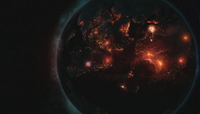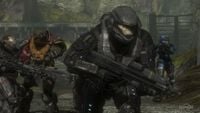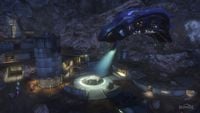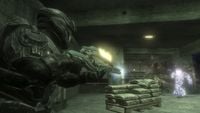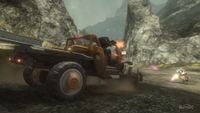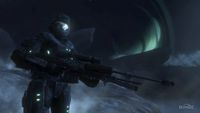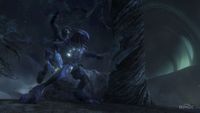Halo: Reach: Difference between revisions
From Halopedia, the Halo wiki
Cally99117 (talk | contribs) |
Cally99117 (talk | contribs) |
||
| Line 153: | Line 153: | ||
File:HaloReach - Screenshot 07.jpg| Noble Six firing a Needle Rifle. | File:HaloReach - Screenshot 07.jpg| Noble Six firing a Needle Rifle. | ||
File:HaloReach - Screenshot 08.jpg| Noble Six in a civilian vehicle. | File:HaloReach - Screenshot 08.jpg| Noble Six in a civilian vehicle. | ||
File:HaloReach - Screenshot 09.jpg| Noble Six shooting at a group of Covenant troops. | |||
Action_00.jpg|The HUD in ''Halo: Reach''. | Action_00.jpg|The HUD in ''Halo: Reach''. | ||
Action_04.jpg|A Marine and Noble Six secure a room. | Action_04.jpg|A Marine and Noble Six secure a room. | ||
Revision as of 10:44, January 25, 2010
Halo: Reach (previously known as "Halo 4" [1]) is an upcoming first-person shooter video game set in the Halo universe and direct prequel to Halo: Combat Evolved, in-development by Bungie, LLC. [2][3][4]. It was announced by Joe Staten during Microsoft's Media Briefing at E3 2009 in Los Angeles, California, and is set for release in Fall 2010 [5]. Bungie President Harold Ryan commented that Reach may include Project Natal features [6].
An invite to the Multiplayer Beta is included with Halo 3: ODST, with a planned release for Spring 2010.
Development
- "Where there will be a full three-year cycle, it's got all-new tech, akin to the change from Halo 2 to Halo 3, not like ODST, which is just built on top of the foundation."
- — Bungie Community Manager, Brian Jarrard.
Reach has been in development since the completion of Halo 3, in the tradition of a full three year cycle, and will use a completely new game engine created specifically for the game. It was confirmed in October 2009 that Martin O'Donnell, Bungie's lead composer, had begun casting voice actors for Reach [7]. While only a year away from release, Reach's environment architecture, cinematic script, and most in-game encounters have been either completely finished or polished [8]; in addition, many properties of Reach have been placed in the game and are currently playable.
Gameplay
Halo: Reach will feature many new additions to the Halo sandbox, while still retaining the core gameplay. The health system will be similar to that of Halo: Combat Evolved and Halo 3: ODST, and the player's energy shields will recharge slower than in Halo 3. The HUD will highlight environmental features and overlay information about them, and the Motion Sensor display will be three-dimensional. It will also feature a night vision like in Halo 3: ODST. Halo: Reach also introduces a refined Equipment system known as "Armor Abilities". Pieces of equipment will now be reusable, with a cooldown time between uses. A new assassination system will also be featured, in which holding down the melee button will trigger a context-sensitive, third-person assassination animation. This mechanic will presumably replace the old instant-kill assassinations.
The weapon selection has been streamlined from that of Halo 3, so that every weapon has a specific role. The number of different grenade types has also been reduced from that of Halo 3, and Type-3 Antipersonnel/Antimatériel Incendiary Grenades or Type-2 Antipersonnel Fragmentation Grenades will not be returning. Human weapons all hit more or less instantly after pulling the trigger, giving them a more powerful feel.
Players will be able to personalize their character's armor, and the appearance will be consistent across singleplayer, co-op and multiplayer. Like in Halo 3, the armor permutations will only be aesthetic and not affect gameplay. While the rest of Noble Team will accompany the player for most of the game, Halo: Reach will not feature any kind of tactical squad mechanic. Much like Thel 'Vadam in Halo 3, the rest of the squad will fight alongside the player, but will not require any assistance. The levels will be more open and teleportation in co-op will be far less strict.[9][10]
Engine
Bungie is using a completely redone version of the Halo engine for Halo: Reach, with no component left untouched.
The environments, while larger than in the previous games, will be far more detailed. The graphical effects have been drastically improved, allowing for a new atmospheric effects system and more dynamic lighting for dramatic shadows and moving light sources in interiors. Rain and fogging effects will also be improved. Halo: Reach also features a new animation system, which smoothly blends movement between standing, walking and running as well as jumps, grenade throws and firing. The facial animation system has been completely revamped, including motion capture. Weapon effects will be amplified to be more powerful and visceral than before, giving the effects a more serious tone. Human weapons will sound more powerful and emit smoke and showers of sparks. Plasma bolts will now burn through material as they hit, and explosions will throw clouds of dirt and debris around.
Halo: Reach's engine will be able to support up to 40 active AI characters and 20 vehicles on screen at once. In addition, faraway battles between AI characters will follow automated behavior models, which convert into scripted behaviors as the player gets closer, and finally full AI.[9][10]
Design
Bungie has taken a new design direction with Halo: Reach, aiming for a more somber and gritty atmosphere. In many ways, the character designs, especially those of Sangheili and Human personnel, harken back to Halo: Combat Evolved. Models for enemies and allies boast remarkable levels of new detail in form of higher-resolution textures and more polygons. Enemies and allies will have more individual features to denote ranks and provide more visual variety. The Covenant will speak in their own languages, and feel more alien and threatening in general.
As of now, it has been stated that the Halo Theme will not appear in the game, but there may be some foreshadowing of Halo themes.[9][10]
Appearances
Trivia
- In an interview with Worthplaying, Brian Jarrard hinted that Gunnery Sergeant Edward Buck, one of the main characters in ODST, may return in Reach.[11] Another hint to the character's possible return came in a G4 interview with Bungie about ODST, where Joseph Staten said "It would be a shame if we make a game about the planet Reach -- a place where Buck, the ODST’s squad leader, was known to be -- and not have him appear in some way shape or form…" [12]
- On December 12, 2009, during the Spike TV 2009 VGAs, an exclusive look at Halo: Reach premiered [13]. The game's opening cinematic was shown, revealing the squad, and also that the Sangheili will indeed be returning as enemies, as the Sangheili were part of the Covenant through Halo Wars to the latter part of Halo 2, after being allies in Halo 3 and absent in Halo 3: ODST.
- On the project page for Reach, located in the "Multimedia" section, the soundtrack to the cinematic trailer called "Lone Wolf" by Martin O'Donnell, is available for free downloading from Bungie.net. The song is 2:27 long.
Gallery
Concept Art
- Concept 01.jpg
A Sangheili attacks two UNSC Marines.
- Concept 02.jpg
Emile-A239, Jorge-052 and Carter-A259.
- Concept 03.jpg
Spartans, UNSC Marines and civilians.
- Concept 04.jpg
Landscape on Reach.
- Concept 05.jpg
A bridge leading over a canyon.
Screenshots
- Reach friggit wreck.png
A destroyed UNSC Frigate over Reach.
Reach being glassed by the Covenant.
- Halo Reach Main Character.jpg
A render of Noble Six.
- HaloReach - Screenshot 01.jpg
Emile-A239 in a valley.
- HaloReach - Screenshot 02.jpg
Noble Six secures a site.
Skirmishers in Reach.
A Phantom in Reach.
- HaloReach - Screenshot 06.jpg
Noble Six with Emile-A239.
- HaloReach - Screenshot 09.jpg
Noble Six shooting at a group of Covenant troops.
- Action 00.jpg
The HUD in Halo: Reach.
- Action 04.jpg
A Marine and Noble Six secure a room.
Sources
- ^ ONI Candidate Assessment Program V5.02A - Site Page Info
- ^ Microsoft E3'09 Media Briefing
- ^ Bungie.net - Halo Reach
- ^ Worthplaying.com - 'Halo 3: ODST' (X360) Developer Interview
- ^ Official Halo: Reach page at Xbox.com
- ^ Seattle Times.com - Developers at Bungie ready to spring new heroes in the 'Halo' universe
- ^ Bungie.net - Bungie Weekly Update 10/16/2009
- ^ Bungie.net - Bungie Weekly Update 10/23/2009
- ^ a b c EDGE Magazine, February 2010
- ^ a b c GameInformer, February 2010
- ^ Worthplaying.com - 'Halo 3: ODST' (X360) Developer Interview
- ^ G4TV.com - Reaction Time: Bungie reflects on Halo 3: ODST
- ^ GameTrailers.com - VGA Announcement: Halo Reach
Links
Internal
- Halo: The Fall of Reach
- Halo: First Strike
- Halo: Reach - Announcement Trailer
- Halo: Reach Video Games Awards Trailer
- Reach

